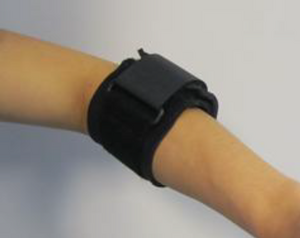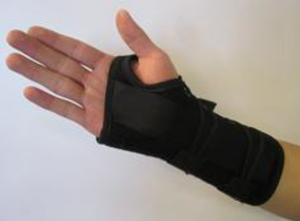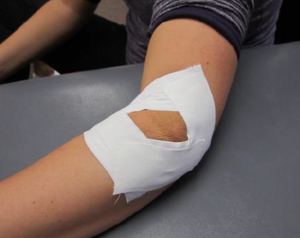Lateral Epicondyle Tendinopathy Toolkit: Section H - Braces, Splints, and Taping: Difference between revisions
No edit summary |
m (Protected "Lateral Epicondyle Tendinopathy Toolkit: Section H - Braces, Splints, and Taping" ([Edit=⧼protect-level-ppadmin⧽] (indefinite) [Move=⧼protect-level-ppadmin⧽] (indefinite))) |
||
| (35 intermediate revisions by 3 users not shown) | |||
| Line 1: | Line 1: | ||
<div class="editorbox"> | <div class="editorbox"> | ||
''' | '''Original Editor '''- [[User:Vidya Acharya|Vidya Acharya]] for '''BC Physical Therapy Tendinopathy Task Force:''' | ||
Dr. Joseph Anthony, Paul Blazey, Dr. Allison Ezzat, Dr. Angela Fearon, Diana Hughes, Carol Kennedy, Dr. Alex Scott, Michael Yates and Alison Hoens | |||
< | '''Top Contributors''' - {{Special:Contributors/{{FULLPAGENAME}}}}</div> | ||
== Introduction == | == Introduction == | ||
Various methods have been developed to treat lateral epicondyle tendinopathy that includes brace, [[Splinting|splints]] and [[taping]] | Various methods have been developed to treat [[Lateral Epicondylitis|lateral epicondyle tendinopathy]] that includes brace, [[Splinting|splints]] and [[taping]]. It has been found that splinting, bracing, and taping are useful interventions for protecting, stabilising, or immobilising injured or inflamed areas. | ||
== Counterforce Brace == | |||
<div class="flex-row row"> | |||
<div class="col-md-8"> | |||
A counterforce brace is one of the most conventional treatments. The mechanism of action for this brace is the transferring of stress from the wounded tissue to the unaffected tissues around it. A combined cadaveric and clinical study<ref>Meyer NJ, Walter F, Haines B, Orton D, Daley RA. [https://pubmed.ncbi.nlm.nih.gov/12671861/ Modeled evidence of force reduction at the extensor carpi radialis brevis origin with the forearm support band.] The Journal of hand surgery. 2003 Mar 1;28(2):279-87.</ref> showed a 13-15% force reduction of the [[Extensor Carpi Radialis Brevis]] origin with the counterforce brace. | |||
* They are often used for pain relief. | |||
* They are thought to diffuse the load through the tendon to less sensitive areas, thereby decreasing the stress on the area of pathology. | |||
</div> | |||
<div class="text-center" "col-md-4">[[File:LET_Appendix_E_Fig1.png|alt=|frameless]]</div> | |||
</div> | |||
== Wrist Splint == | == Wrist Splint == | ||
<div class="flex-row row"> | |||
<div class="col-md-8"> | |||
< | |||
Wrist splints reduces tension and load at the extensor origin, thus promoting tendon repair. | |||
* Wrist splints are less commonly used in the Lateral Epicondyle Tendinopathy. | |||
* But they do have some support for temporary pain relief in more acute patients. | |||
* The goal is to rest the musculotendinous unit originating at the lateral epicondyle. | |||
</div> | |||
<div class="text-center" "col-md-4">[[File:LET_Appendix_E_Fig2.png|alt=|frameless]]</div> | |||
</div> | |||
== Diamond Taping Technique == | |||
<div class="flex-row row"> | |||
<div class="col-md-8"> | |||
Taping provides support and stability for the preventing injury as well as it protects the injured anatomical structure during healing. | |||
* The goal is to decrease tension at the epicondyle attachment. | |||
* Diamond Taping Technique <ref>Vicenzino B, Brooksbank J, Minto J, Offord S, Paungmali A. [https://pubmed.ncbi.nlm.nih.gov/12918865/ Initial effects of elbow taping on pain-free grip strength and pressure pain threshold.] Journal of Orthopaedic & Sports Physical Therapy. Jul 2003; 33(7): 400-7.</ref>consists of four tape strips, repeated twice. | |||
* The tape is laid in a diamond shape while pulling the soft tissues centrally towards the lateral epicondyle. | |||
</div> | |||
<div class="text-center" "col-md-4">[[File:LET_Appendix_E_Fig3.png|alt=|frameless]]</div> | |||
</div> | |||
== | == Supporting Evidence == | ||
There is differing evidence to support the use of orthotic devices and taping to treat LET. The evidence is summarised below; for more information, please see [[Lateral Epicondyle Tendinopathy Toolkit: Section D - Summary of the Evidence|Section D - Summary of the Evidence for Physical Therapy Interventions]]. | |||
'''Orthotic devices''' | |||
* Acute Stage: There is weak evidence that orthotic devices (brace, sleeve or splint) may reduce immediate pain compared to placebo. There is weak evidence that a counterforce brace may reduce pain in the short term (<6 weeks).<ref name=":0">Shahabi S, Bagheri Lankarani K, et al. [https://pubmed.ncbi.nlm.nih.gov/32635812/ The effects of counterforce brace on pain in subjects with lateral elbow tendinopathy: A systematic review and meta-analysis of randomized controlled trials.] Prosthet Orthot Int. 2020 Oct;44(5):341-354</ref> | |||
* Chronic Stage: A placebo-controlled RCT showed that addition of a counterforce brace to exercise-based rehabilitation may result in improved pain and function in the short and long terms<ref>Heales LJ, McClintock SR, Maynard S, et al. [https://pubmed.ncbi.nlm.nih.gov/32452393/ Evaluating the immediate effect of forearm and wrist orthoses on pain and function in individuals with lateral elbow tendinopathy: A systematic review.] Musculoskelet Sci Pract. 2020 Jun;47:102147</ref><ref>Kroslak M, Pirapakaran K, Murrell GAC. [https://pubmed.ncbi.nlm.nih.gov/30658774/ Counterforce bracing of lateral epicondylitis: a prospective, randomized, double-blinded, placebo-controlled clinical trial.] J Shoulder Elbow Surg. 2019 Feb;28(2):288- 295</ref> | |||
'''Taping''' | |||
* Chronic Stage: Two placebo controlled trials, and two experimental studies have demonstrated efficacy of taping for providing immediate pain relief. Taping has not been consistently shown to benefit strength. Studies have often been conducted alongside an exercise intervention.<ref>Vicenzino B, Brooksbank J, Minto J, et al. [https://pubmed.ncbi.nlm.nih.gov/12918865/ Initial effects of elbow taping on pain-free grip strength and pressure pain threshold.] Journal of Orthopaedic & Sports Physical Therapy. Jul 2003; 33(7): 400-7.</ref><ref>Balevi ISY, Karaoglan B, Batur EB, et al. [https://pubmed.ncbi.nlm.nih.gov/34736818/ Evaluation of short-term and residual effects of Kinesio taping in chronic lateral epicondylitis: A randomized, double-blinded, controlled trial.] J Hand Ther. 2021 Nov 1:S0894-1130(21)00144-7.</ref><ref>Shamsoddini, A., Hollisaz, MT. [https://www.ncbi.nlm.nih.gov/pmc/articles/PMC3860678/ Effects of Taping on Pain, Grip Strength and Wrist Extension Force in Patients with Tennis Elbow.] Trauma monthly 18.2 (2013): 71-4.</ref> | |||
== Resources == | == Resources == | ||
[ | *[[Lateral Epicondyle Tendinopathy (Tennis Elbow) Toolkit|Lateral Epicondyle Tendinopathy Toolkit page]] | ||
*[[Lateral Epicondyle Tendinopathy Toolkit: Section B - Clinical Assessment|LET Section B - Clinical Assessment of LET]] | |||
[ | *[[Lateral Epicondyle Tendinopathy Toolkit: Section C - Outcome Measures|LET Section C - Outcome Measures]] | ||
*[[Lateral Epicondyle Tendinopathy Toolkit: Section D - Summary of the Evidence|LET Section D - Summary of the Evidence]] | |||
*[[Lateral Epicondyle Tendinopathy Toolkit: Section E - Exercise Prescription|LET Section E - Exercise Prescription]] | |||
*[[Lateral Epicondyle Tendinopathy Toolkit: Section G - LASER Dosage Calculation|LET Section G - LASER Dosage Calculation]] | |||
*[[Lateral Epicondyle Tendinopathy Toolkit: Section F - Manual Therapy|LET Section F - Manual Therapy]] | |||
* [https://physicaltherapy.med.ubc.ca/physical-therapy-knowledge-broker/lateral-epicondyle-tendinopathy-let-toolkit/ UBC Lateral Epicondyle Tendinopathy (LET) Toolkit <br />] | |||
<br> | |||
== References == | == References == | ||
| Line 77: | Line 78: | ||
[[Category:Clinical Guidelines]] | [[Category:Clinical Guidelines]] | ||
[[Category:Elbow - Guidelines]] | [[Category:Elbow - Guidelines]] | ||
[[Category:PT Knowledge Broker Project]] | |||
Latest revision as of 17:24, 1 December 2022
Original Editor - Vidya Acharya for BC Physical Therapy Tendinopathy Task Force:
Dr. Joseph Anthony, Paul Blazey, Dr. Allison Ezzat, Dr. Angela Fearon, Diana Hughes, Carol Kennedy, Dr. Alex Scott, Michael Yates and Alison Hoens
Top Contributors - Vidya Acharya, Kim Jackson, Evan Thomas, Admin, Wanda van Niekerk, Rishika Babburu and 127.0.0.1Introduction[edit | edit source]
Various methods have been developed to treat lateral epicondyle tendinopathy that includes brace, splints and taping. It has been found that splinting, bracing, and taping are useful interventions for protecting, stabilising, or immobilising injured or inflamed areas.
Counterforce Brace[edit | edit source]
A counterforce brace is one of the most conventional treatments. The mechanism of action for this brace is the transferring of stress from the wounded tissue to the unaffected tissues around it. A combined cadaveric and clinical study[1] showed a 13-15% force reduction of the Extensor Carpi Radialis Brevis origin with the counterforce brace.
- They are often used for pain relief.
- They are thought to diffuse the load through the tendon to less sensitive areas, thereby decreasing the stress on the area of pathology.
Wrist Splint[edit | edit source]
Wrist splints reduces tension and load at the extensor origin, thus promoting tendon repair.
- Wrist splints are less commonly used in the Lateral Epicondyle Tendinopathy.
- But they do have some support for temporary pain relief in more acute patients.
- The goal is to rest the musculotendinous unit originating at the lateral epicondyle.
Diamond Taping Technique[edit | edit source]
Taping provides support and stability for the preventing injury as well as it protects the injured anatomical structure during healing.
- The goal is to decrease tension at the epicondyle attachment.
- Diamond Taping Technique [2]consists of four tape strips, repeated twice.
- The tape is laid in a diamond shape while pulling the soft tissues centrally towards the lateral epicondyle.
Supporting Evidence[edit | edit source]
There is differing evidence to support the use of orthotic devices and taping to treat LET. The evidence is summarised below; for more information, please see Section D - Summary of the Evidence for Physical Therapy Interventions.
Orthotic devices
- Acute Stage: There is weak evidence that orthotic devices (brace, sleeve or splint) may reduce immediate pain compared to placebo. There is weak evidence that a counterforce brace may reduce pain in the short term (<6 weeks).[3]
- Chronic Stage: A placebo-controlled RCT showed that addition of a counterforce brace to exercise-based rehabilitation may result in improved pain and function in the short and long terms[4][5]
Taping
- Chronic Stage: Two placebo controlled trials, and two experimental studies have demonstrated efficacy of taping for providing immediate pain relief. Taping has not been consistently shown to benefit strength. Studies have often been conducted alongside an exercise intervention.[6][7][8]
Resources[edit | edit source]
- Lateral Epicondyle Tendinopathy Toolkit page
- LET Section B - Clinical Assessment of LET
- LET Section C - Outcome Measures
- LET Section D - Summary of the Evidence
- LET Section E - Exercise Prescription
- LET Section G - LASER Dosage Calculation
- LET Section F - Manual Therapy
- UBC Lateral Epicondyle Tendinopathy (LET) Toolkit
References[edit | edit source]
- ↑ Meyer NJ, Walter F, Haines B, Orton D, Daley RA. Modeled evidence of force reduction at the extensor carpi radialis brevis origin with the forearm support band. The Journal of hand surgery. 2003 Mar 1;28(2):279-87.
- ↑ Vicenzino B, Brooksbank J, Minto J, Offord S, Paungmali A. Initial effects of elbow taping on pain-free grip strength and pressure pain threshold. Journal of Orthopaedic & Sports Physical Therapy. Jul 2003; 33(7): 400-7.
- ↑ Shahabi S, Bagheri Lankarani K, et al. The effects of counterforce brace on pain in subjects with lateral elbow tendinopathy: A systematic review and meta-analysis of randomized controlled trials. Prosthet Orthot Int. 2020 Oct;44(5):341-354
- ↑ Heales LJ, McClintock SR, Maynard S, et al. Evaluating the immediate effect of forearm and wrist orthoses on pain and function in individuals with lateral elbow tendinopathy: A systematic review. Musculoskelet Sci Pract. 2020 Jun;47:102147
- ↑ Kroslak M, Pirapakaran K, Murrell GAC. Counterforce bracing of lateral epicondylitis: a prospective, randomized, double-blinded, placebo-controlled clinical trial. J Shoulder Elbow Surg. 2019 Feb;28(2):288- 295
- ↑ Vicenzino B, Brooksbank J, Minto J, et al. Initial effects of elbow taping on pain-free grip strength and pressure pain threshold. Journal of Orthopaedic & Sports Physical Therapy. Jul 2003; 33(7): 400-7.
- ↑ Balevi ISY, Karaoglan B, Batur EB, et al. Evaluation of short-term and residual effects of Kinesio taping in chronic lateral epicondylitis: A randomized, double-blinded, controlled trial. J Hand Ther. 2021 Nov 1:S0894-1130(21)00144-7.
- ↑ Shamsoddini, A., Hollisaz, MT. Effects of Taping on Pain, Grip Strength and Wrist Extension Force in Patients with Tennis Elbow. Trauma monthly 18.2 (2013): 71-4.









